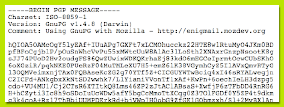

HTW Berlin
Fachbereich 4
Internationaler Studiengang
Internationale Medieninformatik (Bachelor)
Aktuelle Themen: Cryptography
Winter Term 2016/17

|

|
HTW Berlin |
Lab 6: Symmetric Key Programming
Note that - unless noted otherwise - you work in groups of two! The report is due the evening before your next lecture!